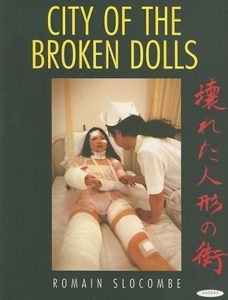 By ROMAIN SLOCOMBE (Velvet Publications; 1996)
By ROMAIN SLOCOMBE (Velvet Publications; 1996)
Fully comprehending this self-described “Medical Art Diary” takes some doing. It’s a strange piece of work, being a collection of grainy black and white photos whose imagery, consisting mostly of injured Japanese women, seems a far cry from the eroticism promised by the book’s packaging.
Romain Slocombe is a French artist and photographer with a fetish for injured Japanese women. He’s said to have completely monopolized this particular field in a number of picture books, of which CITY OF THE BROKEN DOLLS (the only one of them to be given an English language edition) is the most popular.
CITY’S photos are neither as gory nor as sexy as you might expect. This is reflected in the introduction by the underground film legend Richard Kern, who seems downright puzzled by the book’s content. Recalling finding an earlier edition in a sex shop, Kern wonders “why it was being sold there—it seemed like a well-planned conceptual art book,” and admits “Looking at the book made me feel vaguely uneasy.”
Its photographs, taken during the years 1993-96, encompass both verite street scenes and artfully posed modelling shots. In both cases realism appears to have been Slocombe’s overriding goal, with the aforementioned graininess and harsh natural lighting being constants. These aren’t fetish photos meant to evoke an erotic response in the viewer so much as glimpses into one man’s very particular obsessions. The book concludes with a photographic index that fills us in on the particulars of each photo, but no such identifiers are present in the main portion, which consists of the photographs and nothing else.
Pictured are surreptitiously captured scenes of heavily bandaged Japanese women in hospital beds, as well as similarly afflicted ladies in sexually suggestive poses and dominatrixes in bondage gear performing mock surgical procedures. There are also depictions of non-injured women walking Tokyo’s streets and riding its subways, and people-less shots of various parts of the city (usually at night), showing that Slocombe’s obsessions stretch far beyond depictions of injured women.
So no, I didn’t find this book particularly erotic. What I did find was that it exerts a quirky and vaguely disturbing fascination in its exploration of the darker edges of its creator’s psyche, as well as that of an entire city—a city in which, one senses, Romain Slocombe’s proclivities aren’t too out of place.
